30 Nov Akbar The Great’s Coronation Platform
The Takht-i-Akbari still stands amid the swaying fields of Punjab
Kalanaur is a village in Punjab that few have heard of, let alone visited. Yet, this small settlement close to the border with Pakistan and about an hour’s drive from Amritsar, has made an oversized contribution to Indian history. For it was here, on February 14th 1556, that a young and unruly boy-prince, the fourteen year old Jalaluddin Muhammad Akbar, was crowned the King of Hindustan.
Akbar padshah’s brick coronation platform, the Takht-i-Akbari, still stands among the swaying wheat fields of Kalanaur as a mute reminder that this is where it all began for one of India’s most famous rulers. Not in the celebrated corridors of Delhi or Lahore or Agra – all of them cities associated with Akbar – but here, in the rural heart of Punjab.
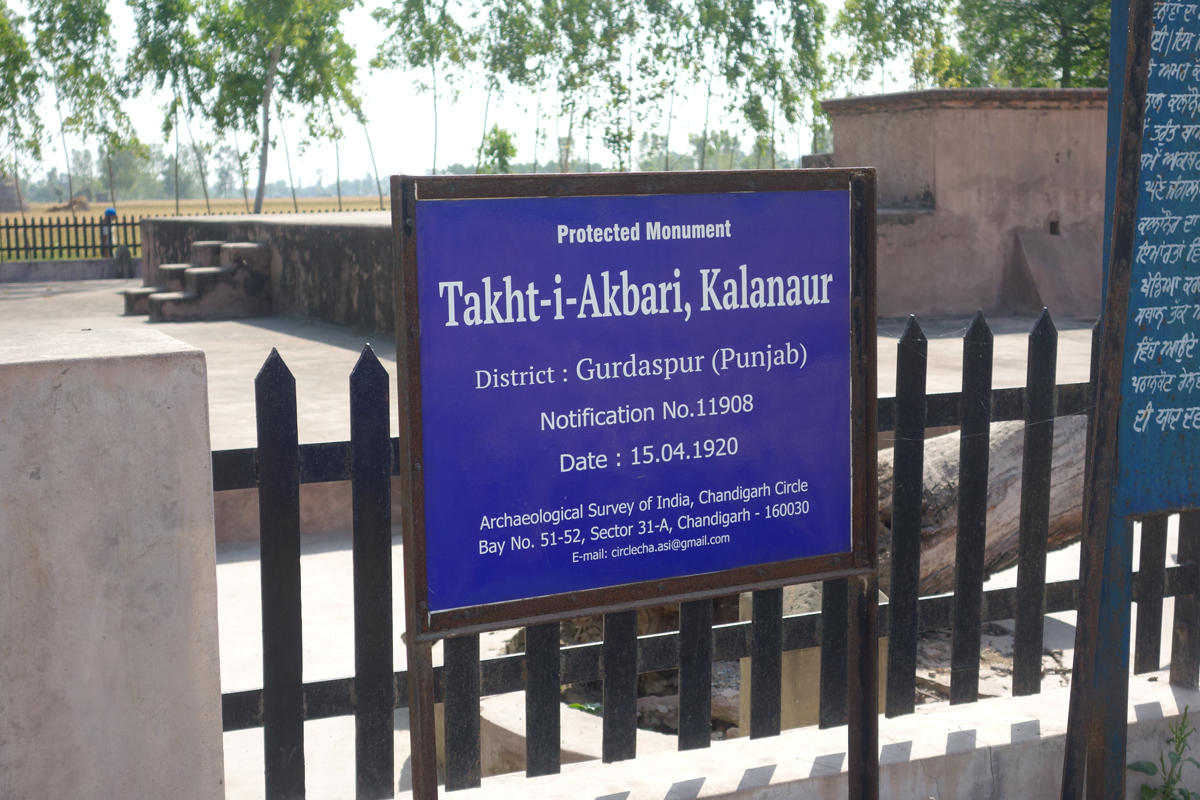
Kalanaur’s Little-Visited Heritage, The ASI Protected Takht-i-Akbari
Kalanaur is difficult to reach when treated as a one-off. But, if combined with a visit to Amritsar and the Golden Temple it makes for a perfect itinerary. Specially for history buffs like me. I could hardly wait to touch and connect with arguably the greatest king my country has produced. What a bonus, barely an hour’s drive from Amritsar.
So, on a bright April morning with a slight winter nip in the air, my driver Simranjeet and I had left Amritsar for Kalanaur. Within a few minutes we were on to the wide highway for Pathankot, Punjabi pop blaring from the car radio. One of the pleasures of driving in Punjab is the soothing view of lush fields stretching to the horizon. It was Spring, a few days before Baisakhi, and the wheat had turned a ripe golden yellow, being ready for harvesting. As we drove, Simranjeet kept up a constant chatter.
“Sirji, did you know Baisakhi is celebrated even in Canada?”
“Sirji, farmers have now banned the lighting of fires at Spring. Because their dry crops could get burnt.”
“Sirji, earlier we had eucalyptus trees lining these highways. Now it is poplar, much better for making plywood and matchsticks.”
Occasional brick kilns dotted the landscape, standing erect in the yellow-green fields emitting lazy plumes of smoke in to a pale blue sky. Simranjeet had ready information on this too….
“Sirji, these kilns are very valuable for farmers for an extra income. The kiln owners buy clay for bricks from their fields.”
Just before reaching Batala, we came off the highway on to a narrow country road, driving past small communities with names like Taragarh and Dharamkot. This was typical rural Punjab ; villagers gossiped at hand pumps while filling water into their vessels, chickens for sale clucked from behind wire-mesh cages, impatient kids gathered around sugarcane juice stalls doing brisk business. By mid-morning, after a pleasant hour’s drive from Amritsar, we entered Kalanaur.
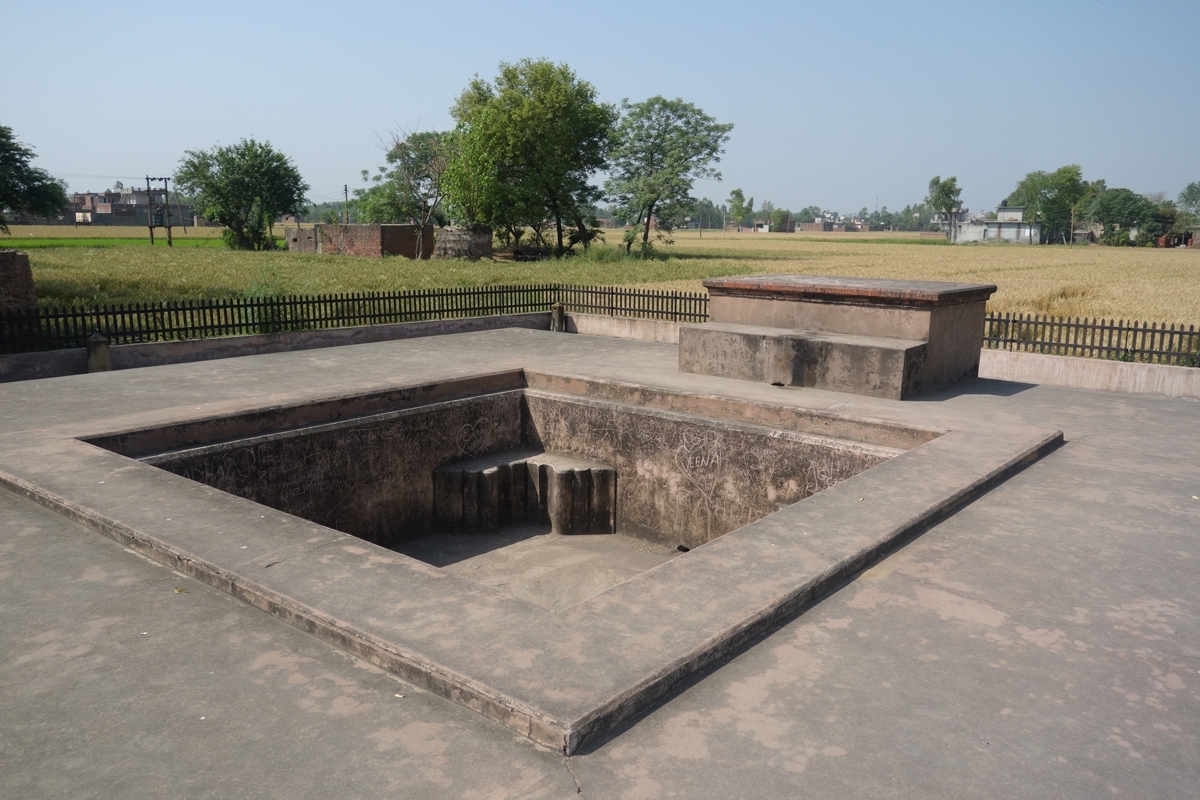
Akbar’s Coronation Platform : Where the fourteen-year old Boy-King was crowned King Of Hindustan
The villagers of Kalanaur clearly knew their legacy. I was quickly pointed the way to the Takht-i-Akbari, and also informed of the village’s other attractions; a famous Shiv Mandir, and the Gurdwara Banda Bahadur. We drove on to a kuccha track, leaving the village behind us and lurching through waist-high wheat fields. In the middle of the fields, we passed the haunting ruins of the once-imposing Akbari Masjid, which from the size of its massive pillars and the fine carvings still visible must have been an impressive structure in its prime. Besides its broken remains was a small shrine with a single grave draped in a green cloth. I stopped to have a look, and the villagers told me this was part of the Akbari masjid and was now looked after by the locals.
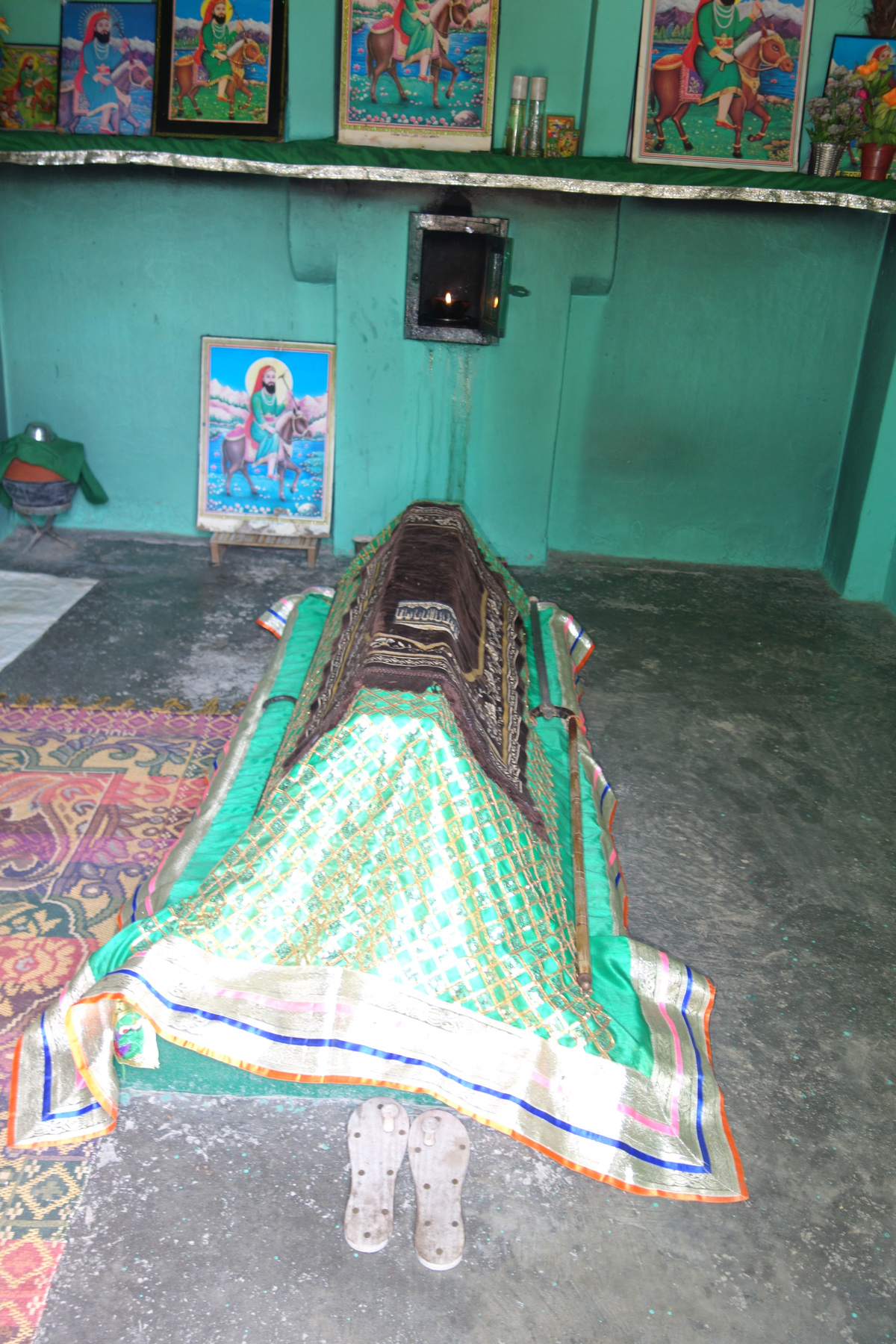
Next to the Haunting Pillars of the Akbari Mosque is a one-grave shrine, maintained as a living legacy by the locals of Kalanaur
And then suddenly in front of us, surrounded on all sides by ripe wheat fields, was a neatly fenced enclosure with a bright blue ASI sign; the Takht-i-Akbari.
I stepped out of the car to take in the scene. Birds twittering, fresh air, and the gurgling sound of clear water. Akbar’s coronation platform lies quietly in the middle of this pastoral setting. A small tabela had a few cud-chewing buffaloes looking at me quizzically. There was an overwhelming silence and peace. As I looked over the coronation platform and the tranquil fields, I tried imagining this site five hundred years ago.
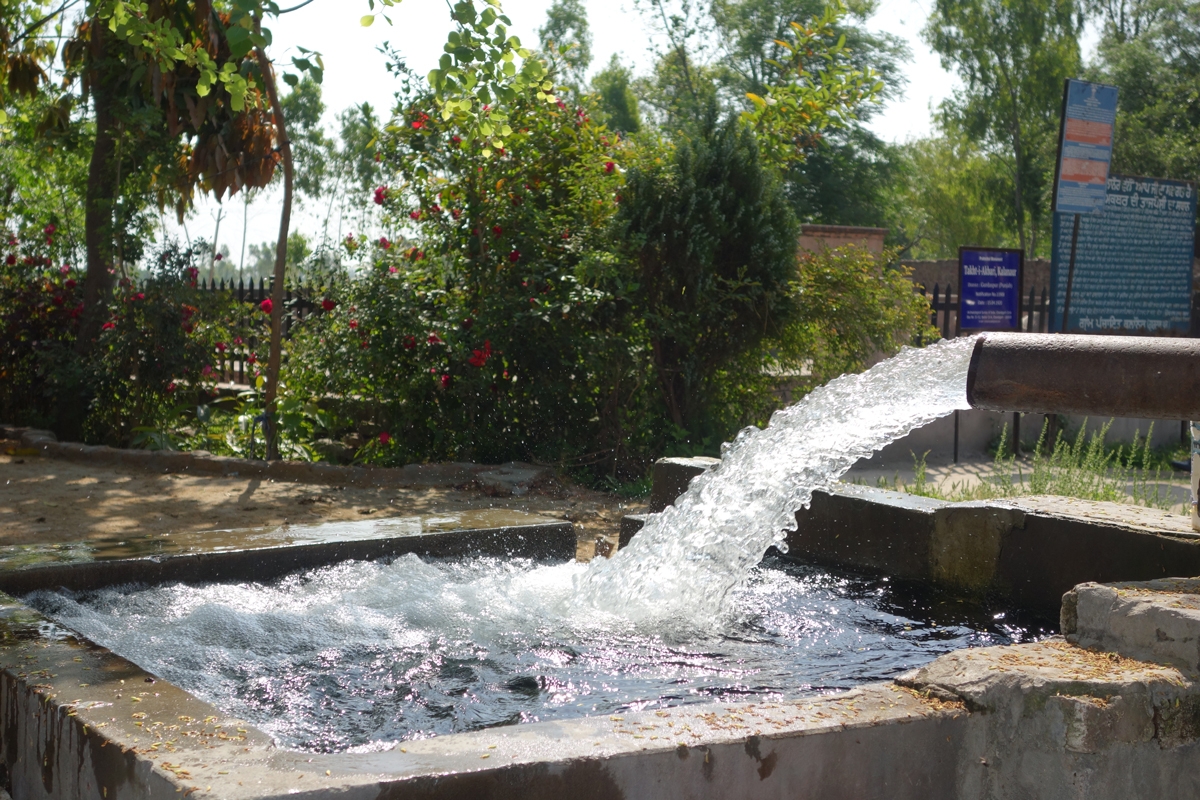
The Gurgling Sound of Fresh Water…a Farmer’s Tabela now adjoins Akbar’s Historic Takh
The Takht-i-Akbari was hastily erected by Bairam Khan, young Akbar’s guardian and tutor, when he received the news of Akbar’s father, Emperor Humayun’s death. Humayun died suddenly and unexpectedly, slipping on the stairs of his library in Delhi’s Purana Qila, and Bairam Khan decided on quick action. He was camped at Kalanaur, close to the Ravi river, with the young prince Akbar and the Mughal army. According to the court historian Abul Fazl, when Akbar heard the news of his father’s death, he broke down and wept “as much for himself as for his lovable though eccentric father. The burden of the empire was on him suddenly, and he was not yet done with childhood” * Akbar was fourteen at the time.
Bairam Khan wasted no time in formalizing Akbar’s ascension. A masonry platform was built, with a brick throne on top of it. Within a few days of Humayun’s death, by midday on Friday the fourteenth of February 1556, at a time and date considered astrologically auspicious, Akbar was crowned Emperor of Hindustan. Right here in Kalanaur, without any elaborate ceremony.
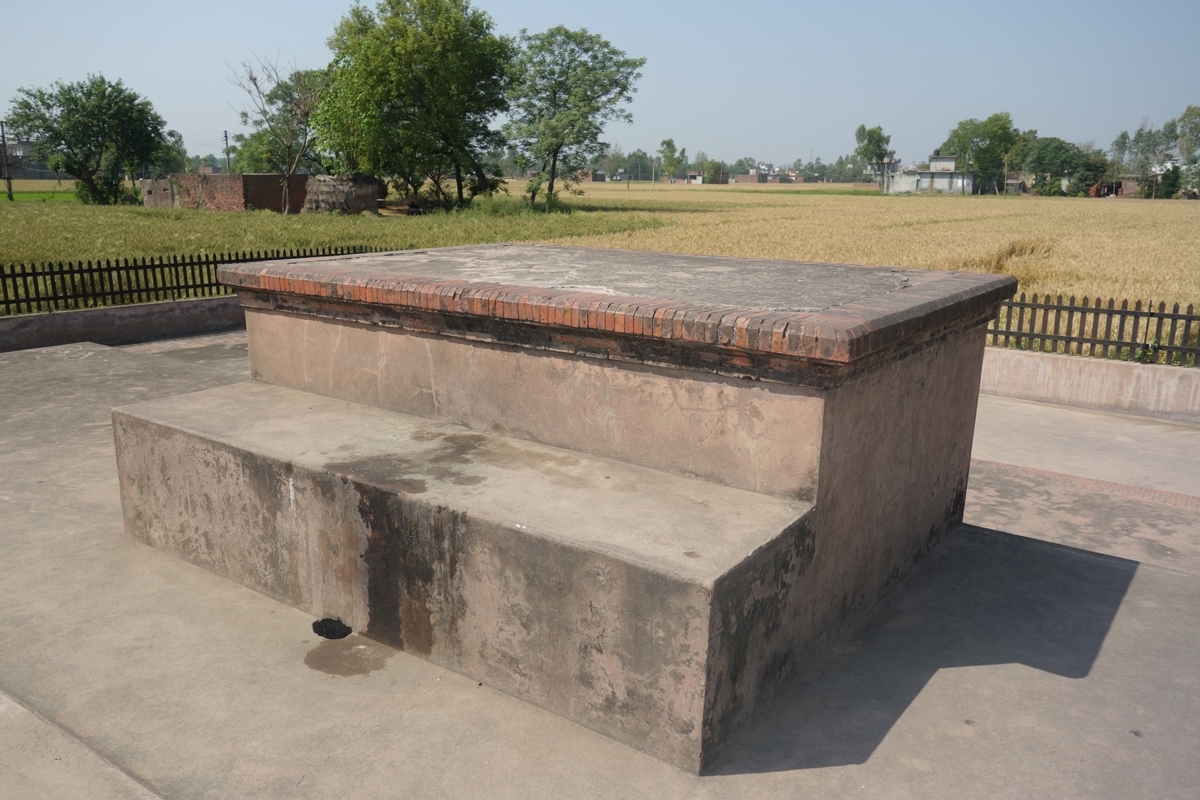
The Brick Throne where Akbar the Great sat, to be Crowned the Next Mughal King
Nevertheless, this was after all the Mughal Empire. Whatever be the need for haste, some pageantry, style and grace was mandatory. There is a water feature in the middle of the Takht-i-Akbari. A square water tank, about five feet deep, is set in to the coronation platform with floral carvings on the four corners. As I climbed down in to the water tank, I thought to myself, why the need for this, in the harsh winter cold of February in Punjab? But to lend this impromptu stage some additional flourish and dignity fit for the occasion – the coronation of a Mughal king!
I sat on the brick throne as Akbar had done five centuries ago. To my side would have stood Bairam Khan. In front of me, the vast Mughal army. Neither would realise that in this young prince, “they had not a boy who must be managed, but a master would be obeyed”.
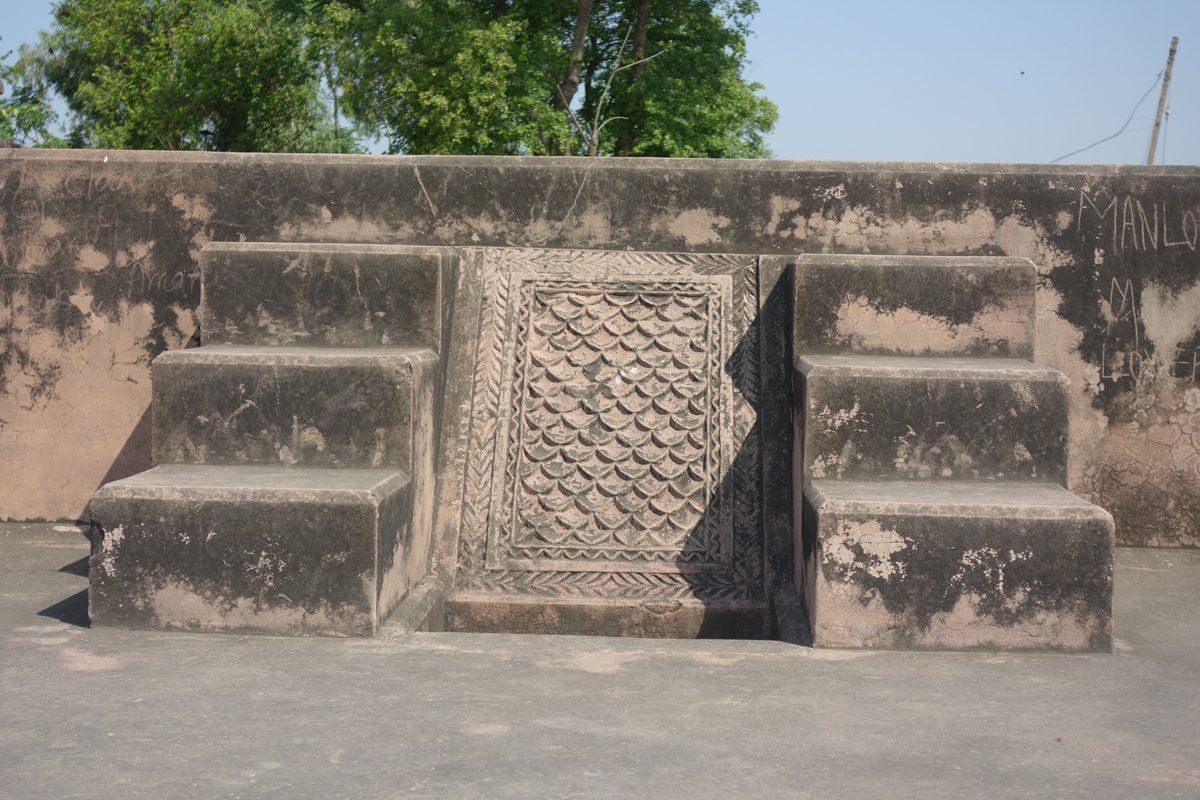
Carved Masonry for the Coronation Platform’s Water Feature; Some Style and Grace to Befit The Occasion
As I took in the remote isolation of the Takht-i-Akbari, with just the soft gurgle of flowing water and the undulating wheat fields for company, I felt an indescribable sadness and poignancy in the air. Where I was sitting, one of India’s greatest sons had begun his journey. An “illiterate and unruly youth of fourteen” who had gone on to rule India for fifty years and in the words of historian Abraham Eraly “inaugurated the second golden age of India, after the decline of its classical civilization a thousand years earlier” **. This is where a golden-hued chapter in India’s history had started, with Akbar creating a mighty Mughal empire, famous all over the world and synonymous with India. And yet, the Takht-i-Akbari is quietly forgotten, with just a handful of history enthusiasts interested enough to visit. There are no statues, no ceremony; no recognition for one of India’s best.
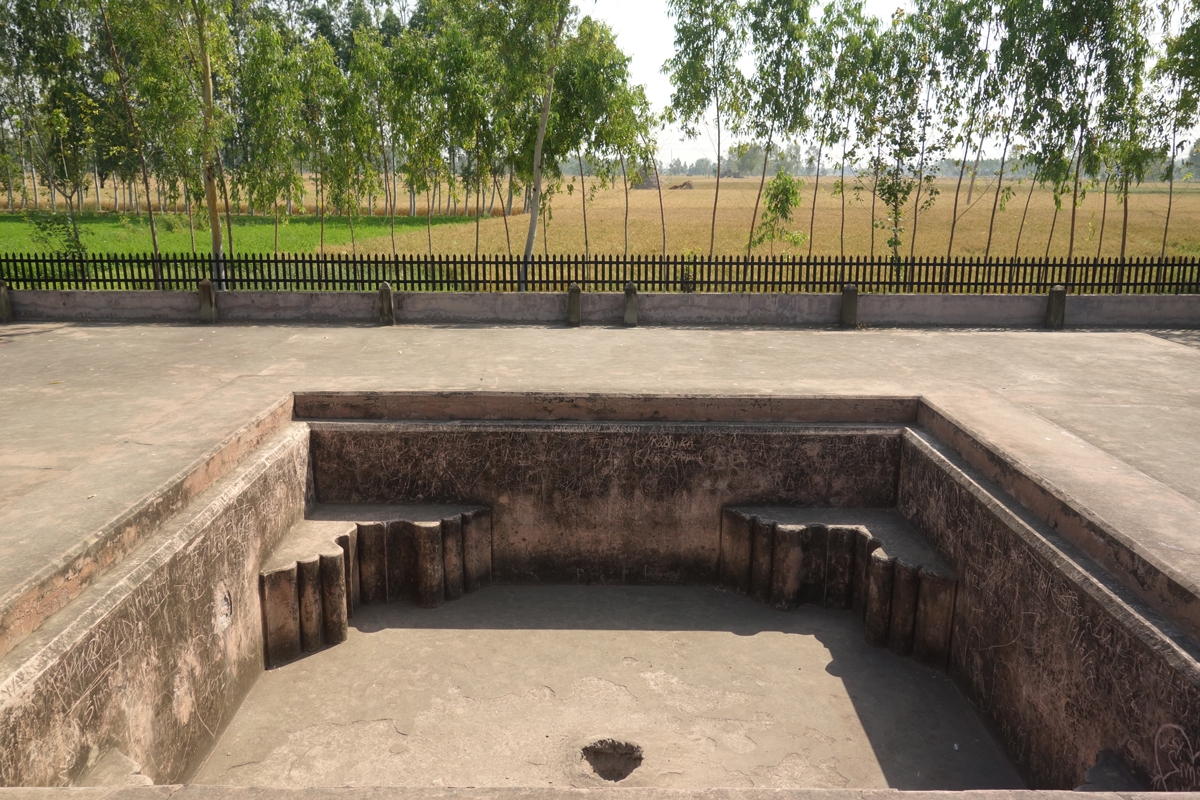
The Emperor’s View; The Scene From on top of Akbar’s Throne
While I was busy clicking photographs, I was approached by the gentle Harbhajan Singh. Harbhajan works on these fields, and is paid a modest five thousand rupees a month by the ASI for maintaining the Takht-i-Akbari. He does a fine job. The enclosure was neat and well swept, with no litter. I complimented Harbhajan and his son on their excellent work, and signed the red coloured ASI visitor’s register he had with him.
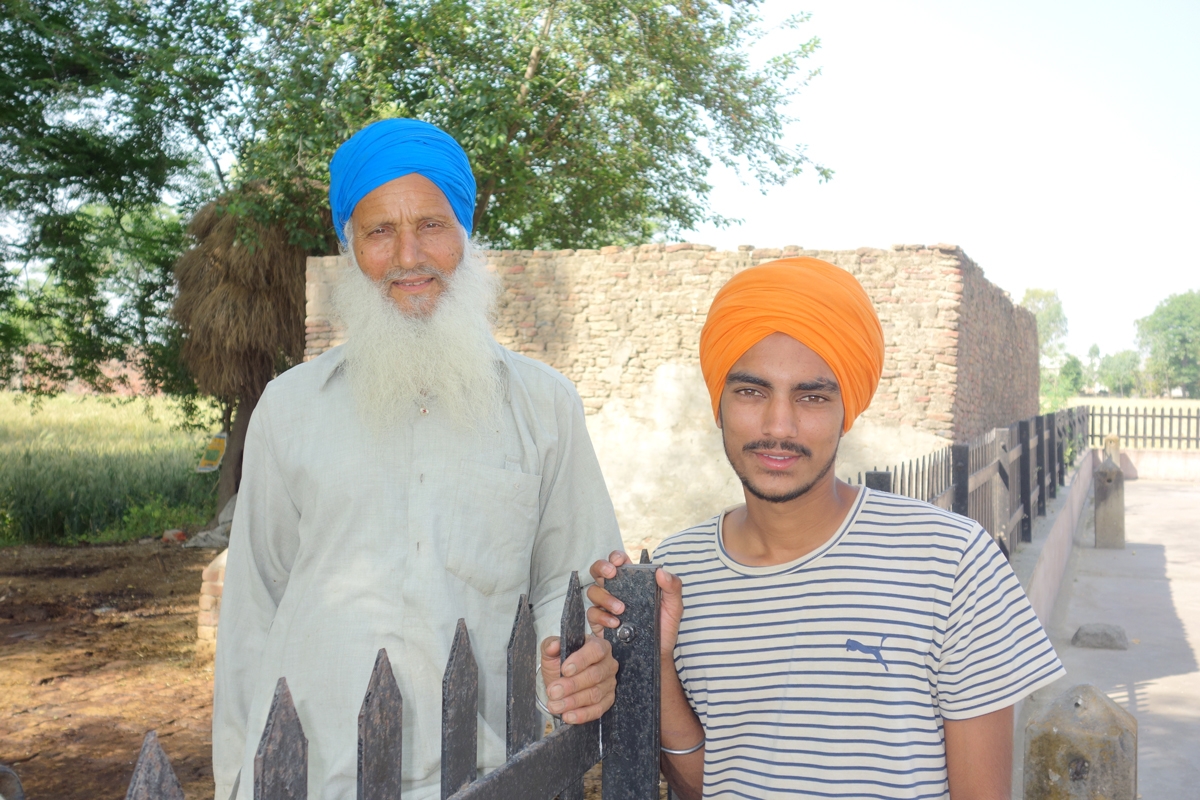
Harbhajan Singh and His Son keep The Takht-i-Akbari Spotless and Clean
The sun was now hot in a cloudless sky as I returned to the air conditioned comfort of Simranjeet’s Innova. There were still the other attractions of Kalanaur to visit ; Gurdwara Banda Bahadur and the Shiv Mandir. Simranjeet, who when we started the journey had no idea about this historical gem in his own backyard, asked me how I was liking the visit. What could I say? I was a bit overwhelmed and still taking it all in. Just the thought that where I was standing, events that had shaped the history of India had been created, left me in awe. Is there any other place in the world where one could sit on the coronation throne of the country’s most famous ruler? And, be so close to historical legacy as to actually touch it and feel it for oneself…
I was due to visit two religious places in the next hour at Kalanaur, and I knew exactly what to pray for; that these remarkable monuments which dot our country remain forever protected and cared for. Not only for our benefit but for the future generations as well; to visit and to recognise and love the richness of their own heritage and history.
* Abraham Eraly : “The Last Spring. The Saga of the Great Mughals. Part 1”. Page 114.
** Abraham Eraly : “The Last Spring. Life in India’s Last Golden Age. Part II”. Prologue.
Praying at Kalanaur
Opposite Kalanaur’s hectic bus station is an arched gateway to the village’s old Shiv temple, famous locally for its Shivratri mela. According to legend, Lord Shiva had rested in Kalanaur, so the Shivalingam in the temple lies horizontal instead of vertical, which makes it unique.
The temple’s white marble courtyard was empty when I visited, apart from the temple workers washing it down. Buckets of water were splashed on to the cool marble floor as big brooms scrubbed it clean. I took off my shoes, and left footprints on the wet marble as i entered the mandir. There was nobody inside the temple, and I was left undisturbed. By the time I emerged, a few other devotees had entered the compound. Temple bells were being rung, each with its own distinct sound. I tipped the cleaners washing the temple, and then rang the temple bells as well.
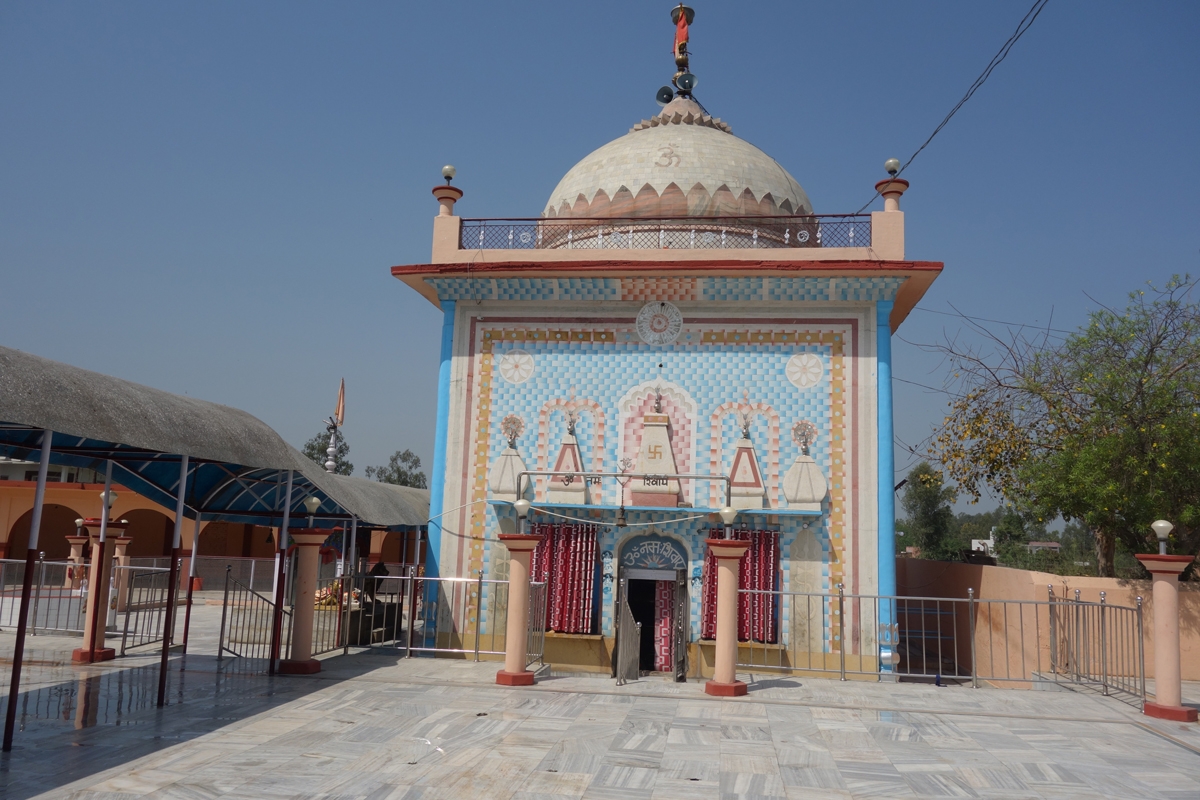
The Single domed Old Shiv Temple at Kalanaur
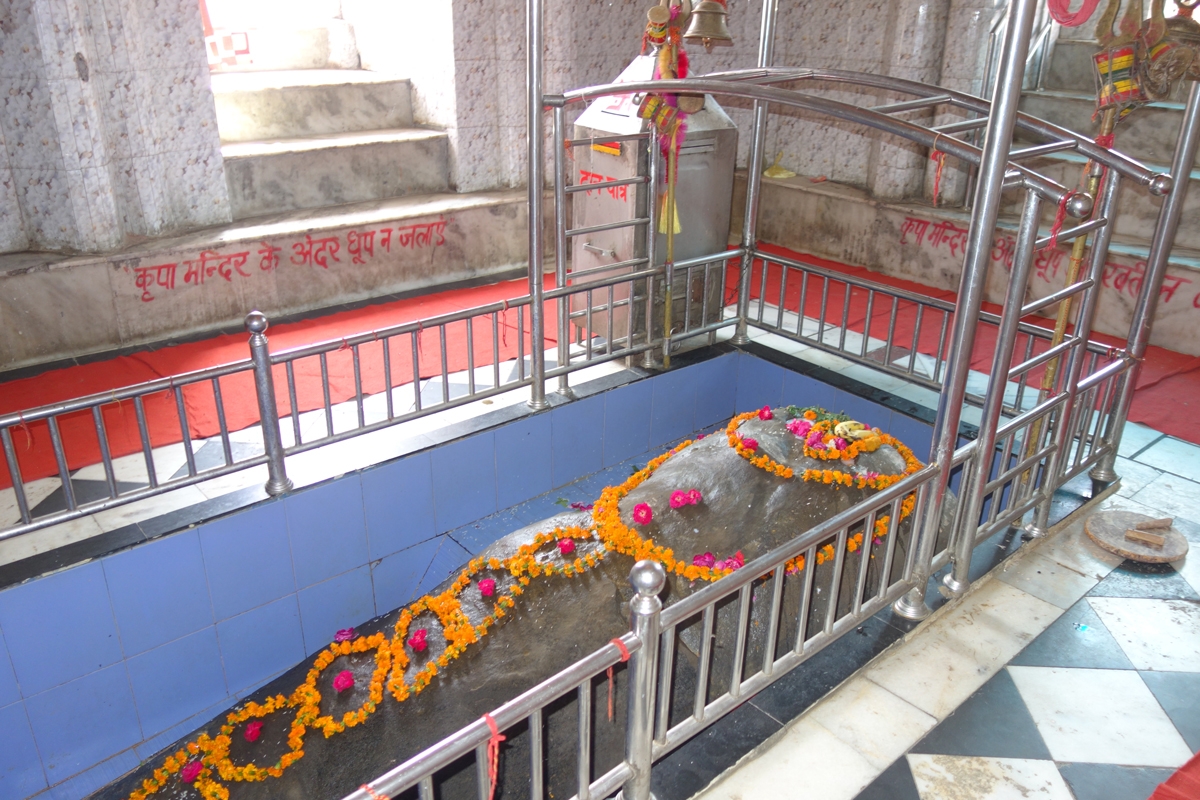
Shiv Temple’s Unique Horizontal Shivlingam, in a lying position
Not far from the Shiv Mandir and at the end of an upward sloping lane, was the Gurdwara Banda Bahadur. In 1715, the heroic Banda Bahadur and his Sikh forces had staged their last great stand against the Mughals, at the famous battle of Gurdas Nangal, just a few miles from here. He had been captured and taken to Delhi in an iron cage, where he was executed in a particularly cruel manner. This Gurdwara is located on the spot where Banda Bahadur had built a well.
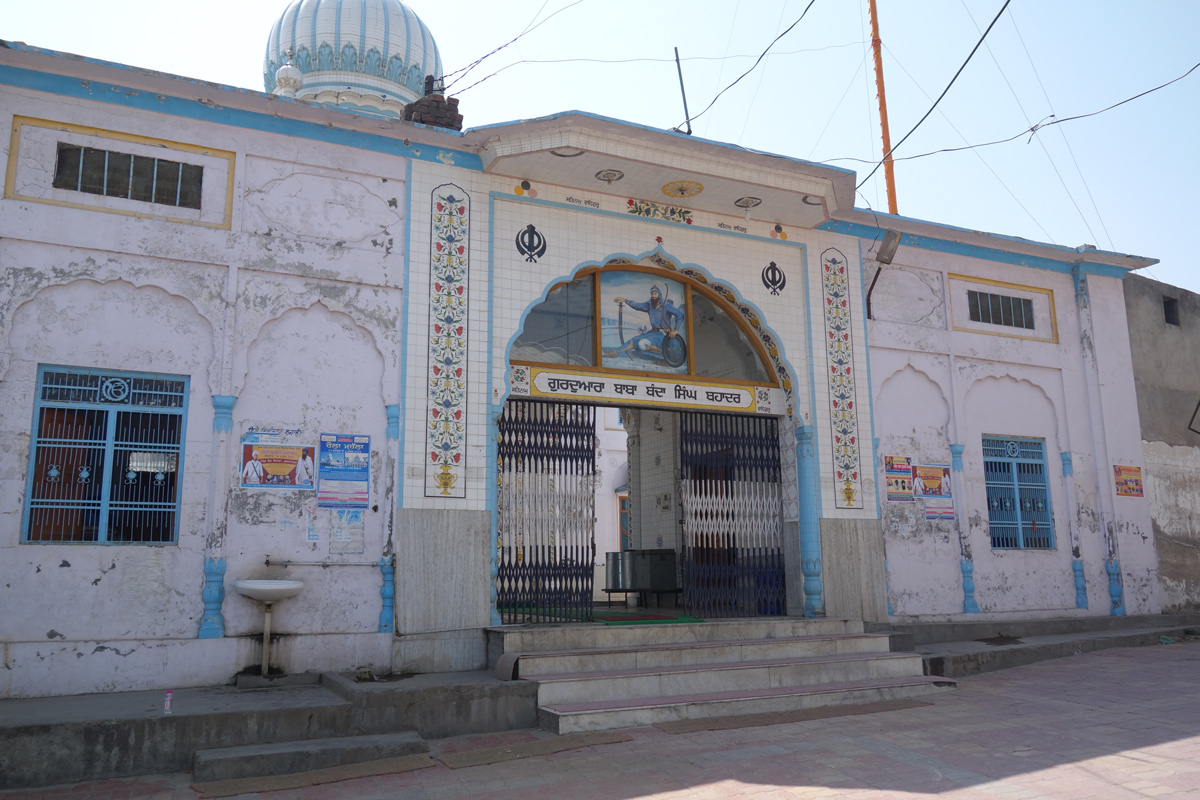
Gurdwara Banda Bahadur, with Banda Bahadur’s mural on the entry gate, is located at the spot where he built a well.
I took off my shoes to enter the Gurdwara, but hesitated as I hadn’t carried a handkerchief to cover my head. An elderly sardar offered to give me his, but his wife mentioned that there were head coverings available at the entry gate. As indeed there were. I pushed open the mesh doors to enter the Gurdwara. Inside, there were about twenty devotees seated on a red carpet ; women on one side and men on the other. The holy Guru Granth Sahib was under a golden canopy. I sat in a corner of the Gurdwara, and once again I prayed.
Akbar and Bairam Khan: love, respect, intrigue and death
Bairam Khan (1510-1561) was born in Badakshan in Central Asia and was of Turki lineage. He served three successive Mughal emperors – Babur, Humayun and Akbar –and being a gifted military general and strong leader of men, was a steady hand on the shoulder for each of these emperors.
During the first four years of Akbar’s rule, while he was still a teenager, Bairam was the real power behind the throne. He more or less co-founded the Mughal empire, removing obstacles and quelling dissent in Punjab and Sind including the decisive defeat of Hemu at the second battle of Panipat, which paved the way for Akbar’s ascent.
Though Bairam Khan was instrumental in his young pupil’s success, Akbar was a willful youth and friction soon grew between them. Early signs of Akbar’s defiance happened within months of his accession, when at the pivotal battle of Panipat a half-dead Hemu was captured and bought to Akbar in battle. Bairam had urged Akbar to “prove his sword” as this was his first war. But Akbar refused, saying, “He is now no better than a dead man, how can I strike him? If he had sense and strength, I would try my sword.” The historian Badauni describes Bairam then slew Hemu himself, sending his head to Kabul as a trophy and his torso to Delhi to be placed on a gibbet*
By the age of eighteen, Akbar was impatient to stand on his own feet. Others around him who were jealous of Bairam’s authority used this to drive a wedge between the two. A plot was hatched for Akbar to leave Agra for Delhi on the pretext of visiting his ailing mother, Hamida. Once Akbar reached Delhi, he wrote to all the top nobles that he had broken with Bairam Khan for his “deviating from the straight path” and Bairam was ordered to go on a pilgrimage to Mecca. On his part, Bairam responded with dignity, submitting to Akbar’s will as he left Agra with his close relatives.
Once Bairam reached Rajasthan, he unexpectedly spun around in revolt. The reason was the coterie around Akbar overplaying their hand. Trying to humiliate a proud person who was already down, Maham Anga, Akbar’s wet nurse, decided to send a general to escort Bairam out of the empire to make sure he left. She unwisely chose Pir Mohammed, a man recently sacked by Bairam as a servant, being rather eloquently directed to “..draw in your feet under the blanket of disappointment, and sit in a corner”.
Bairam’s revolt was short lived. When he was captured and bought before the Mughal emperor, Akbar rose to the occasion treating his former guardian with the highest grace and respect. Abul Fazi writes that as Bairam approached the royal camp, “..all the emirs and khans went out, by the emperor’s order, to meet him, and conducted him to the emperor with every mark and honor”. Then, Akbar “with his sacred hand raised Bairam Khan’s head from the ground of humiliation and embraced him. He took the cloth from his neck and wiped from his face the tears of penitence and the dust of shame. With his gracious lips he enquired about his health and bade him sit on his right side, as had been the rule when Bairam Khan was prime minister”.
Akbar offered Bairam three options ; staying on in court as advisor, retiring to any fief of his choice in India, or going on pilgrimage to Mecca. Bairam chose the last. A few days after this meeting with Akbar, Bairam resumed his route to Mecca and reached Patan in Gujarat where he set up camp. At Patan, Bairam visited the Sahastralinga Tank (which still exists), where he was recognized by a gang of Afghans loyal to Hemu, whom Bairam had defeated and killed at the Panipat battle. He was set upon by the Afghans and stabbed to death. There was no one to bury his body, which lay unattended “in the dust and in his blood…till some fakirs and poor men lifted up his bloody corpse and committed it to earth” writes Abul Fazl.**
Akbar offered Bairam three options ; staying on in court as advisor, retiring to any fief of his choice in India, or going on pilgrimage to Mecca. Bairam chose the last. A few days after this meeting with Akbar, Bairam resumed his route to Mecca and reached Patan in Gujarat where he set up camp. At Patan, Bairam visited the Sahastralinga Tank (which still exists), where he was recognized by a gang of Afghans loyal to Hemu, whom Bairam had defeated and killed at the Panipat battle. He was set upon by the Afghans and stabbed to death. There was no one to bury his body, which lay unattended “in the dust and in his blood…till some fakirs and poor men lifted up his bloody corpse and committed it to earth” writes Abul Fazl.**
It was a sad end for a great man. But, Akbar saw to it that Bairam Khan’s lineage would continue. His family was rescued and bought to Akbar’s court, where Akbar married Bairam’s widow Salima Begum and took responsibility for Bairam’s four-year-old son Abdur Rahim. In later years, Abdur Rahim would scale the same heights as his father, becoming the highest noble in Akbar’s court as Abdur Rahim khan-i-khana.
* Abraham Eraly : “The Last Spring. The Saga of the Great Mughals. Part 1”. Page 122-123.
** Abraham Eraly : “The Last Spring. The Saga of the Great Mughals. Part 1”. Page 131.
New Year’s Eve, Kalanaur style
If ever the youth of Kalanaur want to celebrate New Year at home, they could draw on their own sense of history.
The Babur Nama – the memoirs of Babur written as a diary by the Emperor himself – mentions his tryst with the village. During his march from Kabul towards Delhi, to fight Sultan Ibrahim Lodi at the legendary Battle of Panipat, Babur and his army spent the night of December 31, 1525 in Kalanaur.
Having spent the previous night at Pasrur (a village in Pakistan, near Sialkot), Babur mentions “…getting early to horse and leaving baggage and train in the charge of Shah Mir Hussain and Jan Beg, we bestirred ourselves. We reached Kalanaur in the afternoon and there dismounted. Muhammad Sultan Mirza and Adil Sultan came to wait on me there, together with some begs. (The next morning) we marched early from Kalanaur”.
Thirty years later, Babur’s grandson would also find himself in Kalanaur in winter, to be crowned the King of Hindustan.
How to get here:
- Exit Amritsar, getting on to the highway for Pathankot.
- Just before Batala, turn left off the highway and on to a single lane road towards Dera Baba Nanak.
- About ten kilometers further, follow the signs to turn right for Kalanaur and follow this stretch for another ten kilometers.
- Once you enter the village, ask for Takht-i-Akbari and the Shiv mandir and Gurdwara Banda Bahadur.
Information (for Takht-i-Akbari) :
- Free entry
- No Toilet Facilities
- No Wheelchair Access
Sources:
- Eraly, Abraham. The Last Spring. The Saga of the Great Mughals Part 1 (Published by Penguin Books India 2015)
- Eraly, Abraham. The Last Spring. Life in India’s Last Golden Age. Part II (Published by Penguin Books India 2015)
- Keay, John. A History : From the Earliest Civilizations to The Boom of The Twenty-First Century. (Published by Harper Press, London, 2010)
- Ira Mukhoty. Akbar, the Great Mughal (Published by Aleph Book Co, 2020)
- Annette Susannah Beveridge. Babur Nama translation Vol1 and Vol2. (Published by Oriental Books, New Delhi)

